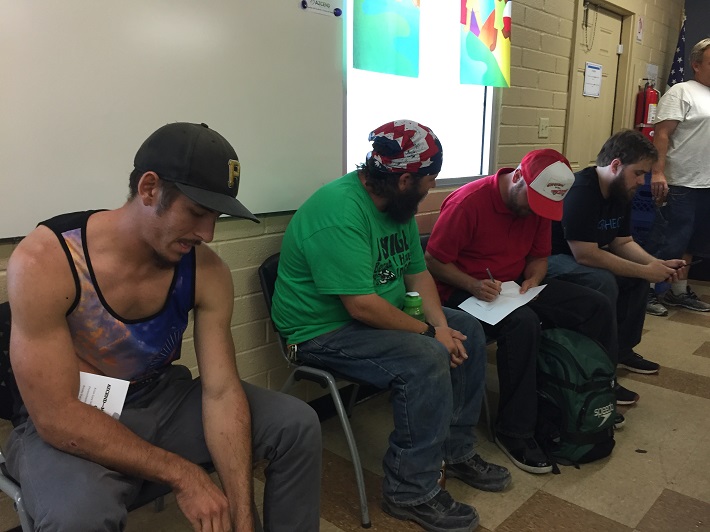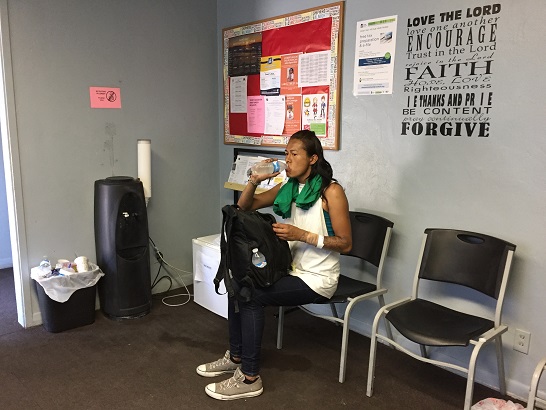
By Deborah Hilcove
It’s HOT. Weeks of triple digit temperatures—with record-breaking highs of 115-120 degrees—mean air-conditioning units are cranking out coolness accompanied by expensive summertime power bills.
Families are stocking up on cases of water and bags of ice. Swimming pools, ice rinks and chilly theaters beckon.
During Arizona’s extreme heat, the sidewalks are scorching, validation perhaps to that old joke about frying an egg on the sidewalk.
The asphalt becomes sticky-hot, even causing Sky Harbor to cancel flights. Inconvenient? For sure. But for those unfortunates living on our streets, the concrete and asphalt become deadly.
During the summer of 2016, in Maricopa County alone, extreme temperatures caused 130 heat-related deaths.
 Thus far in 2017, June temperatures have broken records, but the Maricopa Association of Governments notes that “July is typically the most deadly month in Arizona when it comes to heat-caused deaths. The excessive daytime temperatures, coupled with high nighttime levels, make this time of year very dangerous. The high night temperatures do not allow for the body to cool down and can result in more people being at risk.”
Thus far in 2017, June temperatures have broken records, but the Maricopa Association of Governments notes that “July is typically the most deadly month in Arizona when it comes to heat-caused deaths. The excessive daytime temperatures, coupled with high nighttime levels, make this time of year very dangerous. The high night temperatures do not allow for the body to cool down and can result in more people being at risk.”
Several associations aim to help.
MAG works with city governments to coordinate Heat Relief Network, an organization of faith-based groups, service providers, municipalities, nonprofits, businesses and residents. The agencies, such as Tempe Community Council, have set up hydration and refuge sites where anyone without shelter can rest in the shade and receive free bottles of chilled water. There’s no qualifying and no paperwork.
Says Chandler Vice Mayor Kevin Hartke:
“The goal of the [Heat Relief] network is to provide resources for vulnerable people and help prevent heat-related deaths.”
Hartke, who c0-chairs MAG’s Continuum of Care Board, notes that the Phoenix area averages 110 days of heat above 100 degrees. According to the Arizona Department of Health Services, nearly 2,000 individuals annually receive treatment for such heat-related illnesses as dehydration and heat stroke.
The city of Tempe is an active MAG participant. Kris Baxter-Ging, public information officer, notes that the city’s home page, www.Tempe.gov, lists relief sites and shows whether the station is for shade only, water only or a combination of assistance.
“We have sent PDFs [printed documents] of this information to our staff members who are most likely to encounter people who need help, such as code compliance officers, public works drivers and the like,” she says. “We want to help as many people as possible.”
Nikki Ripley, Tempe’s communication and media relations director, emphasizes the city’s concern for residents with its Homeless Outreach Program Effort.
The program, based at Tempe Public Library, hosts a heat relief and hydration station. Ripley reports that the HOPE team also is passing out water to the homeless.
The city of Chandler is involved with MAG, too.
Chandler Vice Mayor Hartke supervises the city’s involvement, with stations giving out chilled water and providing shady rest areas. At the June 22 City Council meeting, Hartke noted that these stations, or “hot spots,” are located across the city, including fire and police stations. He encouraged residents to join the city’s summer water drive.
Hartke, who also serves as pastor of Trinity Christian Fellowship, is committed to community service and coordinates food arrangements with Resurrection Street Ministries. He said that, with this sweltering heat, a recent challenge has been making sure that people waiting to receive food boxes could stay cool and hydrated.
The Salvation Army of Tempe and Chandler also participates in MAG and has activated its Red Shield Survival Squad, manning heat relief stations. Besides shade, the stations offer cool water, sunscreen, lip balm, hats, cooling towels and bandannas.
In addition to the MAG coordination of heat relief, Tempe Community Action Agency—the city’s largest nonprofit social service agency—coordinates the East Valley iHELP Coalition. The Interfaith Homeless Emergency Lodging Program partners with Tempe, Mesa and Chandler organizations to provide emergency shelter, meals and skills training.
Although each city partner functions independently, they work together to provide inter-community help. Many faith congregations work with iHELP, opening their facilities so homeless “guests” can sleep on their property. Individuals are fed, helped with laundry and provided shelter and the opportunity to shower.
Operating in Tempe every night of the year, teams of volunteers provide 35-40 homeless individuals with dinner and safe shelter. The program assists 43,000 individuals annually—that is one in every four Tempe residents. iHELP says that nearly 22 percent of Tempe residents live in poverty.
Meanwhile, the city of Chandler reported in 2015 that 11.4% of its residents lived below the poverty level. The nonprofit AZCEND, directed by CEO Trinity Donovan, offers help, and during 2016 served over 17,375 people.
Part of the East Valley iHELP Coalition, the social service organization, which formerly known as Chandler Christian Community Center, coordinates the facilities of 18 churches and businesses in the city, providing 365 nights of safety to 25 to 30 adults. During the sweltering summertime heat, this means sleeping in an air-conditioned room, with dinner and access to showers and laundry facilities.
Acknowledging the agency’s efforts, Donovan says:
“I’m grateful our community can come together to help an issue that’s right here in our back yard.”
Homeless people are especially vulnerable to heat-related illnesses during the Valley’s periods of blistering heat, but prolonged heat exposure and dehydration can affect anyone, however healthy they might be. Outdoor workers—including firefighters, landscapers and roofers—are especially at risk.
Some precautions to help avoid heat-related illnesses include staying hydrated; wearing sunscreen, a hat, sunglasses and light clothing; limiting outdoor activity between midmorning and early evening; and resting frequently in shady areas to cool the body’s internal temperature.
It’s also important to check on elderly neighbors living alone to make sure they’re safe and the air conditioning is working. Remember, too, that infants, children and pets should never be left inside a parked vehicle, even for a few minutes.
Will Humble, former director of the Arizona Department of Health Services, has said that excessive heat in desert climates climbs to the top of public health priorities every summer.
“We want to make sure people continue being active, but they have to be smart about it.”
Doing so demands community collaboration, however, he added.
“We all share a community responsibility to help those in need stay cool. One way is to donate water or hold a water drive at your work. The donated water helps people who go to cooling shelters in the extreme heat.”
Many businesses and churches collect water for hydration stations.
For more locations, visit www.maricopa.gov/2461/cooling-stations-water-donation.


